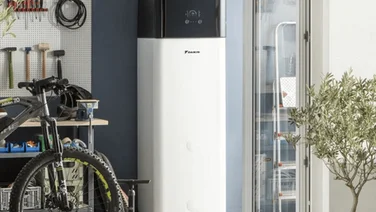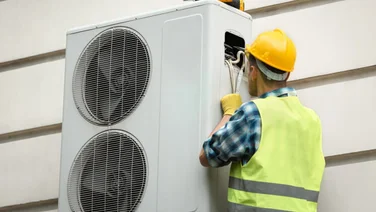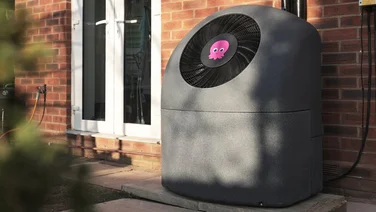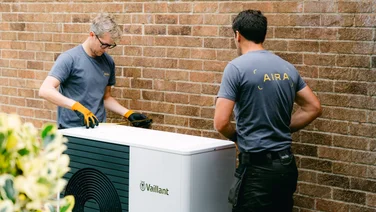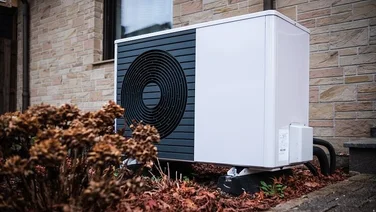- What is an air-to-air heat pump, and how do they work?
- How much does an air-to-air heat pump cost?
- What is the Boiler Upgrade Scheme?
- How is an air-to-air heat pump installed?
- How do I know if my house is suitable for an air-to-air heat pump?
- What are the best alternatives to an air-to-air heat pump?
- Are there any government grants for air-to-air heat pumps?
- Are air-to-air heat pumps popular in the UK?
- Summary
- Depending on the type and size of system, air-to-air heat pumps cost between £3,000 and £15,000
- They can easily double as air conditioning units in summer
- The Boiler Upgrade Scheme doesn’t cover air-to-air heat pumps

Heat pumps, like air-to-air systems, are an efficient, low-carbon alternative to gas and oil boilers, capable of both heating and cooling your home. They work by transferring heat from the air, ground, or water into your property, making them far more energy-efficient than traditional systems.
To date, around 320,000 UK homes now use heat pumps, and with schemes like the Boiler Upgrade Scheme offering up to £7,500 towards installation, they’re becoming more affordable than ever. Beyond conditioning, such systems offer less tangible benefits that include lower carbon emissions, reduced reliance on fossil fuels, and generally low maintenance requirements.
In this guide, we delve into the world of air-to-air heat pumps, what they are, how they’re installed, the typical costs, and how to check if your home is suitable. However, if you are convinced already, to get tailored quotes from trusted suppliers, simply fill in our quick form and compare your options.
What type of central heating do you currently use?
Get startedWhat is an air-to-air heat pump, and how do they work?
Air-to-air heat pumps are a subclass of air source heat pumps (ASHP) that transfer heat from outside air to inside air. Other forms of air-to-air source heat pumps include air-to-water, which operate similarly except they transfer outside air heat to inside water.
In essence, all air-to-air heat pumps are air-source heat pumps, but not all air source heat pumps are air-to-air. These kinds of heat pumps look a lot like traditional air conditioning systems, and in fact, they can do the same job of cooling a room, but they also work in reverse to provide heating.
If you want to know how much a heat pump will set you back, take a look at our heat pump cost calculator.
Instead of creating heat by burning fuel, they capture heat from the outside air and move it inside your home. This makes them highly efficient, as they transfer existing heat rather than generate it from scratch.
They’re common in offices across the UK and widely used in European homes. With UK summers getting hotter and winters still requiring heating, such systems offer year-round comfort in one system. Units range from small, single-room setups to large multi-room installations with independent temperature control in each space.
Most systems comprise two main components:
- Outdoor unit – sits outside the property and extracts or releases heat.
- Indoor unit(s) – mounted on walls or ceilings to distribute warm or cool air.
How an air-to-air heat pump works
In short, the principle is similar to how a fridge works, but in reverse when heating:
- Absorb heat from outside air – Even in cold weather, the outdoor unit contains refrigerant fluid that can absorb heat from the air.
- Compress the refrigerant – The refrigerant, now a gas, is compressed, which raises its temperature (like a bicycle pump getting hot when you inflate a tyre).
- Transfer the heat indoors – The hot gas flows to the indoor unit, where air from your room is blown over the coils, warming it.
- Condense and recycle – As the refrigerant gives up its heat, it condenses back into a liquid and cycles back to the outdoor unit to repeat the process.
- Reverse cycle for cooling – In summer, the system works backwards, moving heat from inside your home to the outdoors.
It is important to note that these systems are typically designed to only heat or cool the air. They aren’t usually used to produce hot water for taps, baths, or showers. If you install one, you’ll still need a separate hot water system (e.g., gas boiler or electric immersion heater).

Want to get a better idea of what it’s like to own an air source heat pump? Check out our case study with Louise, from South London.
Louise had a 12-kilowatt air source heat pump installed to reduce her reliance on fossil fuels, and received £5,000 off the upfront cost through the Boiler Upgrade Scheme. Now, Louise can enjoy a warm, even temperature throughout the house, without fluctuations.
Take a look at the full interview with Louise to learn more.
“Heat pumps are everywhere. We are just slow, very slow [in the UK] using them for domestic heat.” Bean Beanland, Heat Pump Federation, speaking on the Positive Energy podcast.
How much does an air-to-air heat pump cost?
Air-to-air heat pumps cost between £3,000 and £15,000, on average, for most homes in the UK. The price is determined by the size of the system needed, with larger homes requiring larger or more units.
That’s a good deal lower than the cost of an air source heat pump, which is usually £10,000. Though the Boiler Upgrade Scheme will knock £7,500 off the price.
It is also a lot cheaper than other heat pumps, like ground-source. For a three-bedroom house (needing an 8kW system), comparable prices would be around £24,000 for a system of this size.
Installing air-to-air heat pumps is cheaper, too, because you only need to hook the outside unit that extracts the air to the internal blowers that distribute the heat.
Air source heat pumps require new radiators if existing ones aren’t big enough, and new pipework to carry heated water around, making them more expensive to install.
If you’d rather get an estimate for an air source heat pump, check out our heat pump cost calculator.If you want to know more about heat pump costs, read our dedicated page.
What type of central heating do you currently use?
Get startedWhat is the Boiler Upgrade Scheme?
The Boiler Upgrade Scheme (BUS) is a government grant that helps households and small non-domestic buildings in England and Wales switch from fossil fuel heating to low-carbon systems.
The BUS aims to cut this by offering upfront grants towards cleaner heating options. The scheme offers:
- £7,500 off the cost and installation of an air source heat pump (ASHP) or ground source heat pump (GSHP)
- £5,000 off the cost and installation of a biomass boiler
The scheme covers both equipment and installation costs and is available through MCS-certified installers, who can also guide you through the application process.
At present, in the UK, the only available grant to help with the cost of heat pumps is the Boiler Upgrade Scheme. Once the grid is using more renewable energy, the price of electricity will decrease, and this will make heat pumps more affordable to run.
How is an air-to-air heat pump installed?
- Main components: An air-to-air heat pump includes an outdoor unit, internal pipework, and indoor “blowers” in the rooms you want to heat or cool.
- Outdoor unit installation: Placed in a strategic location to minimise the distance to the indoor blowers.
- Pipework installation: Pipes carry refrigerant gas between the outdoor and indoor units; they must be fully sealed to prevent leaks.
- Wall access: Holes are drilled through exterior walls to route the pipes indoors.
- Concealment: Pipe runs are hidden under floors, inside wall voids, or in trunking if concealment isn’t possible.
- Indoor unit installation: Blowers are mounted in recommended locations close to pipework for maximum efficiency.
- Operation: The system heats your home using warm air powered by electricity.
How do I know if my house is suitable for an air-to-air heat pump?
If you live in a smaller property, for example, a two- or three-bedroom semi-detached or terraced house, a bungalow, or a small flat, an air-to-air heat pump can be a highly effective heating and cooling solution. Their efficiency decreases in very large homes, as heat dissipates more quickly in bigger spaces.
Because air-to-air heat pumps only heat (or cool) air, they cannot fully replace a boiler. If you also need hot water for taps, baths, or showers, you’ll require one of the following:
- A gas or oil boiler (existing or new)
- A hot water cylinder powered by an electric immersion heater
- A heat pump water heater
- A solar thermal water heater
What to know before installing an air-to-air heat pump:
- Property size: Smaller homes are generally more efficient to heat with these systems.
- Room layout: Works best when warm air can circulate freely or be targeted to specific rooms.
- Insulation: Good wall, roof, and floor insulation will improve efficiency.
- Space for outdoor unit: Requires an accessible external location with adequate airflow.
- Electrical capacity: May require upgrades to your electrical system.
- Hot water system: Must have a separate system for domestic hot water.
While an electric immersion heater can provide hot water without a gas connection, it is generally more expensive to run than gas.
What are the best alternatives to an air-to-air heat pump?
- Air-to-water heat pumps – Transfer heat from outside air into water for radiators, underfloor heating, and hot water. These are best for replacing a boiler entirely, and typically cost between £7,000 and £18,000 (before grants).
- Ground source heat pumps – Use buried pipework to extract heat from the ground. These are highly efficient but require significant outdoor space and groundwork. These systems are costly, typically costing between £18,000 to £50,000,+ depending on type.
- Water source heat pumps – These units draw heat from a nearby river, lake, pond, or well. They are very efficient but are very location-dependent and may need permits. Costs vary depending on work needed (pipe runs, insulation, etc), but the units themselves typically cost between £6,000 and £11,000 or more.
Pros and cons of air-to-air heat pumps
- They dont' use fossil fuels to run directly
- They are super efficient
- The are highly versatile
- They provide heating and cooling
- They are easy to install
- Low maintenance
- Expensive to install
- They don’t work in cold weather
- They’re noisy
- They take up space
- Systems are not as efficient if your house is big
Are there any government grants for air-to-air heat pumps?
There are currently no government grants for air-to-air heat pumps, because the cost of purchasing and installing the unit is low.
There are government grants for air source heat pumps, which are worth investigating. As it can completely replace your boiler and heat your home, an air source heat pump will be a better value for money in the long run.
Are air-to-air heat pumps popular in the UK?
Yes, out of the 320,000 or so heat pumps in the UK, 225,000 are air-to-air heat pumps, so we can say with some certainty that they are popular. However, the fact that air-to-air heat pumps can’t heat water has limited their residential popularity, because most households need to use an alternative water heating system.
This can be costly and reduces the financial benefits of switching to an air-to-air heat pump. They’re much more popular in the commercial sector, as they provide companies with an affordable way to keep their buildings warm.
The key difference between residential and commercial air-to-air heat pumps is size — units in office buildings are far larger and more powerful. They can provide heat to bigger spaces more efficiently, whereas residential units can only ever be so big.
Summary
- Air-to-air heat pumps are a form of low-carbon heating and cooling as they provide conditioning without burning natural gas, reducing carbon emissions.
- They are highly efficient, able to transfer heat rather than generating it, keeping running costs lower; average installation costs range from £4,000 to £15,000.
- These systems are best for smaller spaces, making them ideal for heating or cooling individual rooms or smaller homes, but you’ll need a separate boiler or hot water cylinder for domestic hot water.
- Simple installation & low maintenance as they are quicker to fit than other heat pumps, with minimal upkeep required.
- If you want to keep your radiators or underfloor heating system, an air-to-water or ground source heat pump (eligible for a £7,500 Boiler Upgrade Scheme grant) may be a better long-term choice.
Ready to start receiving heat pump quotes? Fill in our simple form here with a few details and we’ll put you in touch with our trusted suppliers. They’ll get back to you with bespoke heat pump quotes for you to compare.


